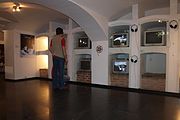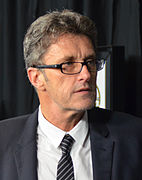Cinema of Poland
| Cinema of Poland | |
|---|---|
Off Plus Camera in Kraków, 2012 | |
| No. of screens | 1,122 (2011)[1] |
| • Per capita | 3.2 per 100,000 (2011)[1] |
| Main distributors | United International Pictures 26.8% Forum Film 12.8% Imperial Cinepix 11.9%[2] |
| Produced feature films (2011)[3] | |
| Fictional | 32 (62.7%) |
| Animated | 1 (2.0%) |
| Documentary | 18 (35.3%) |
| Number of admissions (2011)[5] | |
| Total | 39,663,222 |
| • Per capita | 1 (2012)[4] |
| National films | 11,624,566 (29.3%) |
| Gross box office (2010)[5] | |
| Total | PLN 703 million (~€167.8 million) |
| National films | PLN 43.5 million (~€10.4 million) (6.2%) |
The history of cinema in Poland is almost as long as the history of cinematography, and it has universally recognized achievements, even though Polish films tend to be less commercially available than films from several other European nations.
After
History
Early history
The first
The earliest surviving
During World War I the Polish cinema crossed borders. Films made in Warsaw or Vilnius were often rebranded with German-language intertitles and shown in Berlin. That was how a young actress Pola Negri (born Barbara Apolonia Chałupiec) gained fame in Germany and eventually became one of the European super-stars of silent film.
The first woman to direct a film in Poland and the only female film director of the Polish silent film era was Nina Niovilla.[7][8] She debuted in 1918 in Berlin,[7] and then directed her first Polish film[7] titled Tamara (also known under the title Obrońcy Lwowa) in 1919.[7][8]
During World War II, Polish filmmakers in Great Britain created the anti-Nazi color film Calling Mr. Smith[9][10][11] (1943) about Nazi crimes in occupied Europe and about Nazi propaganda. It was one of the first anti-Nazi films in history being both an avant-garde and a documentary film.
After WWII
In November 1945, the communist government founded the film production and distribution organization
The industry used imported cameras and film stocks. At first ORWO black and white film stock from East Germany and then Eastman colour negative stock and ORWO print stocks for rushes and release prints. Poland made its own lighting equipment. Because of the high costs of film stock Polish films were shot with very low shooting ratios, the amount of film stock used in shooting the film to length of the finished film. The equipment and film stock were not the best and budgets were modest but the film makers received probably the best training in the world from the Polish Film School. Another advantage was Film Polski's status as a state organisation, so its film-makers had access to all Polish institutions and their cooperation in making their films. Film cameras were able to enter almost every aspect of Polish life.
The first film produced in Poland following the World War II was
By the mid 1950s, following the end of
The change in political climate gave rise to the
It is also important to note that during the 1980s, the People's Republic of Poland instituted the
| Part of a series on the |
| Culture of Poland |
|---|
 |
| Traditions |
|
Mythology |
| Cuisine |
| Festivals |
| Religion |
In the 1990s,
Among prominent annual film festivals taking place in Poland are:
Cinema audience
The Communist government invested resources into building a sophisticated cinema audience. All the cinema were state owned and consisted of first run premiere cinema, local cinema and art house cinemas. Tickets were cheap and students and old people received discounts. In the city of Lodz there were 36 cinemas in the 1970s showing films from all over the world. There were the Italian films of Fellini, French comedies, American crime movies such as Don Siegel's "Charley Varrick" . Films were shown in their original versions with Polish subtitles. Anti-Communist and Cold War films were not shown, but a bigger restriction was the cost of some films. There were popular film magazines like "Film" and "Screen", critical magazines such as "Kino". This all helped to build a well informed film audience.
Notable films
Polish Film Academy
The Polish Film Academy was founded in 2003 in Warsaw and aims to provide native filmmakers a forum for discussion and a way to promote the reputation of Polish cinema through publications, presentations, discussions and regular promotion of the subject in the schools.
Awards
Since 2003, the winners of the
|
|
Film schools
Several institutions, both government run and private, provide formal education in various aspects of filmmaking.
- National Film School in Łódź
- Krzysztof Kieślowski Film School at University of Silesia in Katowice
- Szkoła Aktorska Haliny i Jana Machulskich
- Szkoła Wajdy
- AMA Film Academy
- Warszawska Szkoła Filmowa
Personalities
Poland at international festivals
Venice Film Festival
- 1982 Grand Jury Prize (Imperative, Krzysztof Zanussi)
- 1984 Golden Lion (A Year of the Quiet Sun, Krzysztof Zanussi)
- 1993 Golden Lion (Three Colours: Blue, Krzysztof Kieślowski)
- 2010 Grand Jury Prize (Essential Killing, Jerzy Skolimowski)
- 2016 Golden Lion Honorary Award (Jerzy Skolimowski)
Locarno Festival
- 1971 Golden Leopard (Znaki na drodze, Andrzej Piotrowski)
- 1973 Golden Leopard (The Illumination, Krzysztof Zanussi)
- 1986 Jezioro Bodenskie, Janusz Zaorski)
- 2008 Special Jury Prize (33 Scenes from Life, Malgorzata Szumowska)
- 2016 Best Actor Award (Andrzej Seweryn, The Last Family)
San Sebastian International Film Festival
- 1958 Golden Shell for Best Film (Ewa chce spać, Tadeusz Chmielewski)
- 1967 Silver Shell for Best Director (Janusz Morgenstern, Yowita)
- 1976 Silver Shell for Best Actor (Zdzisław Kozien, Skazany)
- 1980 Golden Shell for Best Film (The Orchestra Conductor, Andrzej Wajda)
- 1985 Golden Shell for Best Film (Yesterday, Radosław Piwowarski)
- 1985 Silver Shell for Best Actor (Piotr Siwkiewicz, Yesterday)
- 1989 Silver Shell for Best Director (Mirosław Bork, Konsul)
- 1992 Silver Shell for Best Actress (Krystyna Janda, Zwolnieni z życia)
Cannes Film Festival
- Kanał, Andrzej Wajda)
- 1961 Jury Prize (Mother Joan of the Angels, Jerzy Kawalerowicz)
- Wojciech Jerzy Has)
- 1978 Grand Prix (The Shout, Jerzy Skolimowski)
- 1980 Jury Prize (The Constant Factor, Krzysztof Zanussi)
- 1981 Palme d'Or (Man of Iron, Andrzej Wajda)
- 1982 Best Actress (Jadwiga Jankowska-Cieślak)
- 1988 Jury Prize (A Short Film About Killing, Krzysztof Kieślowski)
- 1990 Best Actress (Krystyna Janda)
- Adam Guzinski)
- 2002 Palme d'Or (The Pianist, Roman Polanski)
- 2018 Best Director (Cold War, Paweł Pawlikowski)
Berlin International Film Festival
- 1965 Silver Bear Grand Jury Prize (Repulsion, Roman Polanski)
- 1976 Silver Bear for Best Actress (Jadwiga Barańska)
- 1980 Silver Bear for Best Actor (Andrzej Seweryn)
- 1981 Silver Bear for Best Actress (Barbara Grabowska)
- 1982 Silver Bear Grand Jury Prize (Shivers, Wojciech Marczewski)
- 1994 Silver Bear for Best Director (Three Colors: White, Krzysztof Kieślowski)
- 2006 Honorary Golden Bear (Andrzej Wajda)
- 2009 Alfred Bauer Prize (Tatarak, Andrzej Wajda)
- Roman Polański)
- Malgorzata Szumowska)
- 2016 Silver Bear for Best Screenplay (United States of Love, Tomasz Wasilewski)
- )
- 2018 Silver Bear Grand Jury Prize (Mug, Małgorzata Szumowska)
Academy Awards
- 1942 Academy Honorary Award (Fantasia, Leopold Stokowski)
- 1954 Academy Award for Best Original Score (Lili, Bronisław Kaper)
- 1983 Academy Award for Best Animated Short Film (Tango, Zbigniew Rybczyński)
- 1994 Academy Award for Best Cinematography (Schindler's List, Janusz Kamiński)
- 1994 Academy Award for Best Production Design (Schindler's List, Allan Starski)
- 1994 Academy Award for Best Production Design (Schindler's List, Ewa Braun)
- 1999 Academy Award for Best Cinematography (Saving Private Ryan, Janusz Kamiński)
- 2000 Academy Honorary Award (Andrzej Wajda)
- Roman Polański)
- Jan A.P. Kaczmarek)
- 2008 Academy Award for Best Animated Short Film (Peter & the Wolf, Suzie Templeton[19])
- Academy Award for Best Foreign Language Film (Ida, Paweł Pawlikowski)
European Film Awards
- 1988 European Film Award for Best Film (A Short Film About Killing, Krzysztof Kieślowski)
- 1989 European Discovery of the Year (300 Miles to Heaven, Maciej Dejczer)
- 1990 European Film Academy Lifetime Achievement Award (Andrzej Wajda)
- 1991 European Film Award for Best Documentary (Hear My Cry, Maciej Drygas)
- 2002 European Film Award for Best Cinematographer (Paweł Edelman, The Pianist)
- Roman Polański)
- 2008 European Film Award for Best Costume Designer (Magdalena Biedrzycka, Katyń)
- 2009 European Film Award for Best Short Film (Poste restane, Marcel Łoziński)
- 2010 European Film Award for Best Short Film (Hanoi – Warsaw, Katarzyna Klimkiewicz)
- Roman Polański, The Ghost Writer)
- Roman Polański, The Ghost Writer)
- 2014 European Film Award for Best Film (Ida, Paweł Pawlikowski)
- 2014 European Film Award for Best Director (Paweł Pawlikowski, Ida)
- 2014 European Film Award for Best Cinematographer (Łukasz Żal and Ryszard Lenczewski, Ida)
- 2014 European Film Award for Best Screenwriter (Paweł Pawlikowski, Ida)
- People's Choice Award for Best European Film (Paweł Pawlikowski, Ida)
- 2015 European Film Award for Best Editor (Jacek Drosio, Body)
- People's Choice Award for Best European Film (Małgorzata Szumowska, Body)
- 2016 European Film Award for Best Sound Designer (Radosław Ochnio, 11 Minutes)
- 2017 European Film Award for Best Animated Feature Film (Loving Vincent, Dorota Kobiela and Hugh Welchman)
- 2017 European Film Award for Best Documentary (Communion, Anna Zamecka)
- 2017 European Film Award for Best Costume Designer (Katarzyna Lewińska, Spoor)
- 2018 European Film Award for Best Film (Cold War, Paweł Pawlikowski)
- 2018 European Film Award for Best Director (Paweł Pawlikowski, Cold War)
- 2018 European Film Award for Best Actress (Joanna Kulig, Cold War)
- 2018 European Film Award for Best Animated Feature Film (Another Day of Life, Raúl de la Fuente and Damian Nenow)
- 2018 European Film Award for Best Editor (Jarosław Kamiński, Cold War)
- 2018 European Film Award for Best Screenwriter (Paweł Pawlikowski, Cold War)
- People's Choice Award for Best European Film (Cold War, Paweł Pawlikowski)
- 2019 European Film Academy Lux Award (Cold War, Paweł Pawlikowski)
- 2022 European Film Award for Best Composer (Paweł Mykietyn, EO)
See also
- Maria and Bogdan Kalinowski
- Cinema of Europe
- Cinema of the world
- History of cinema
- List of famous Poles
- List of film festivals
- List of film formats
- List of film techniques
- List of motion picture-related topics(Extensive alphabetical listing and glossary).
- List of video-related topics
- National Film School in Łódź
- New York Polish Film Festival
- Outline of film
- Piotr Zawojski
- Polish film school
- Seattle Polish Film Festival
- World cinema
- Krzysztof Kieślowski Film School
References
- ^ a b "Table 8: Cinema Infrastructure - Capacity". UNESCO Institute for Statistics. Archived from the original on 24 December 2018. Retrieved 5 November 2013.
- ^ "Table 6: Share of Top 3 distributors (Excel)". UNESCO Institute for Statistics. Archived from the original on 24 December 2018. Retrieved 5 November 2013.
- ^ "Table 1: Feature Film Production - Genre/Method of Shooting". UNESCO Institute for Statistics. Archived from the original on 24 December 2018. Retrieved 5 November 2013.
- ^ "Country Profiles". Europa Cinemas. Archived from the original on 9 November 2013. Retrieved 9 November 2013.
- ^ a b "Table 11: Exhibition - Admissions & Gross Box Office (GBO)". UNESCO Institute for Statistics. Archived from the original on 24 December 2018. Retrieved 5 November 2013.
- ^ Władysław Jewsiewicki (1974), Kazimierz Prószyński (in Polish), Warszawa: Fundacja HINT, p. 49-50, retrieved 2023-11-22
- ^ OCLC 54398332.
- ^ OCLC 1056624930.
- ^ "Calling Mr. Smith - LUX". Archived from the original on 2018-04-25. Retrieved 2018-01-30.
- ^ "L'œuvre Calling Mr Smith - Centre Pompidou". Archived from the original on 2018-01-31. Retrieved 2018-01-30.
- ^ "Franciszka and Stefan Themerson: Calling Mr. Smith (1943)". Archived from the original on 2018-01-31. Retrieved 2018-01-30.
- ISBN 157181275X.
- ISBN 978-1-57181-276-6.
- ^ "Oscar Winners 2020: See the Full List". oscar.go.com. 2020. Retrieved 10 February 2020.
- ^ "Oscar Winners 2019: See the Full List". oscar.go.com. 2019. Retrieved 7 March 2019.
- ^ Benson, Sheila (1990-09-26). "MOVIE REVIEW - 'Interrogation': Janda's Arresting Performance - Los Angeles Times". Los Angeles Times. Retrieved 2009-09-23.
- ^ "Second Run DVD - Interrogation". Second Run DVD. Retrieved 2009-09-24.
- ^ Presentation of the Polish cinema on Eurochannel website
- ^ imdb - Academy Awards, USA[1]
External links
- A Foreigner's Guide to Polish Cinema from Culture.pl
- Polish Cinema in a Concise Way from Kino Mania
Further reading
- ISBN 9781903364611.
![]() Media related to Cinema of Poland at Wikimedia Commons
Media related to Cinema of Poland at Wikimedia Commons
- This article may be expanded with text translated from the corresponding article in the Polish Wikipedia.



















